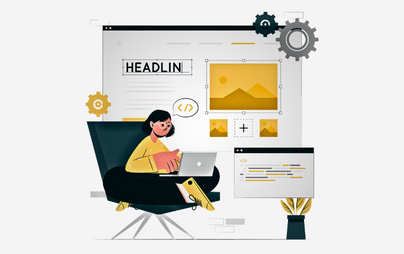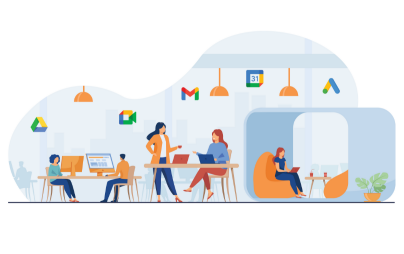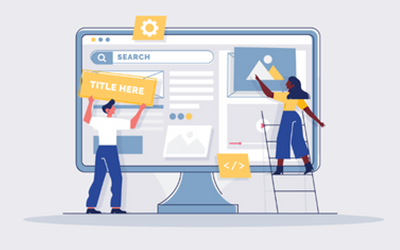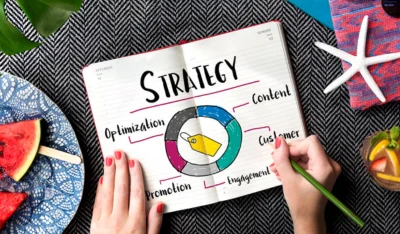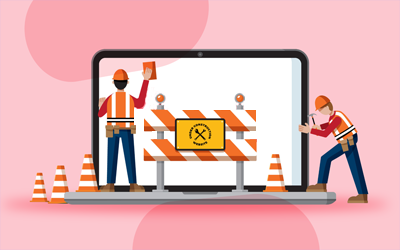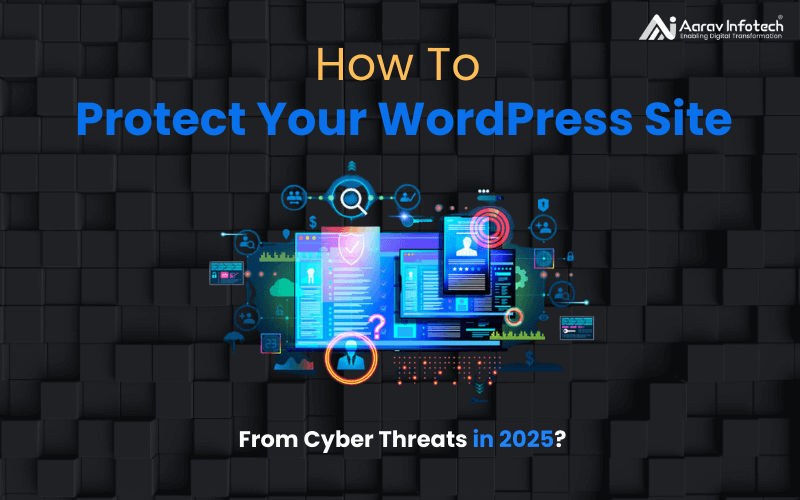In today's digital world, having a well-designed website is essential for any business looking to establish a strong online presence. A well-designed website not only looks visually appealing but also plays a crucial role in engaging and converting potential customers. With so many websites out there, it's essential to ensure your website stands out and meets the needs of your target audience. Here are some top website design tips to help you achieve this:
- Keep your website design simple and uncluttered for a better user experience.
- Use a responsive design to ensure your website looks good on all devices.

- Use high-quality, engaging images to capture your audience's attention.
- Use white space to help your content stand out and make your website easier to navigate.
- Use typography that is easy to read and consistent throughout your website.
- Use a color palette that is consistent with your brand and easy on the eyes.
- Use visual hierarchy to help guide your audience's attention to the most important parts of your website.
- Use a clear and concise headline that accurately reflects your website's purpose.
- Use subheadings to break up large chunks of text and make your content easier to read.
- Use bullet points and numbered lists to organize information and improve readability.
- Use call-to-action buttons to encourage your audience to take action.
- Use high-quality videos to showcase your products or services.
- Use infographics to convey complex information in a visually appealing way.
- Use icons to represent information and make your website more visually appealing.
- Use hover effects to create a more interactive experience for your audience.
- Use parallax scrolling to add depth and dimension to your website.
- Use animations and transitions to create a more dynamic website design.
- Use responsive images to improve website load time and performance.
- Use custom illustrations to add personality and uniqueness to your website.
- Use a consistent layout throughout your website for a cohesive design.
- Use contrast to highlight important information and make your website more visually appealing.
- Use a clear and easy-to-use navigation menu to help your audience find what they're looking for.
- Use breadcrumbs to help your audience understand where they are on your website and how to get back to previous pages.
- Use a search bar to help your audience find specific information on your website.
- Use a footer to provide important information and links at the bottom of your website.
- Use a sidebar to provide additional information and links on your website.
- Use a sticky header to keep your navigation menu visible at all times.
- Use a responsive slider to showcase your products or services.
- Use a custom 404 error page to help your audience find what they're looking for.

- Use a favicon to improve brand recognition and make your website more professional.
- Use consistent branding elements, such as logos and colors, throughout your website.
- Use a responsive font size to ensure your website is readable on all devices.
- Use a responsive grid system to create a balanced and visually appealing layout.
- Use a flat design to create a modern and minimalist website design.
- Use custom buttons to add personality and uniqueness to your website.
- Use a responsive background image to add visual interest to your website.
- Use a consistent image style, such as filters or effects, to create a cohesive design.
- Use whitespace to separate different sections of your website and make it easier to navigate.
- Use a responsive slider to showcase your team or client testimonials.
- Use social media icons to encourage your audience to follow you on social media.
- Use a responsive accordion menu to provide additional information without cluttering your website.
- Use a responsive drop-down menu to organize information and improve website navigation.
- Use a responsive mega menu to provide a comprehensive overview of your website.
- Use a responsive off-canvas menu to save space and provide easy access to important information.
- Use custom graphics to create a unique and memorable website design.
- Use a responsive card design to organize information and make your website more visually appealing
- Use a responsive card design to organize information and make your website more visually appealing.
- Use a consistent design style throughout your website to create a cohesive look and feel.
- Use a grid-based layout to create balance and symmetry in your website design.
- Use a fixed header to keep your branding and navigation menu visible at all times.
- Use custom icons and graphics to add personality and uniqueness to your website.
- Use a responsive hero image to create a powerful visual impact on your website.
- Use a responsive image gallery to showcase your products or services in an organized manner.
- Use a responsive form design to make it easy for your audience to fill out and submit forms.
- Use a responsive menu design to provide easy navigation on all devices.
- Use a responsive footer design to provide important information and links at the bottom of your website.
- Use a responsive timeline design to showcase your company's history or progress.
- Use a responsive pricing table to showcase your products or services in a clear and organized way.
- Use a responsive blog layout to make your content easy to read and navigate.
- Use a responsive product page layout to showcase your products and encourage conversions.
- Use a responsive portfolio layout to showcase your work and build credibility.
- Use a responsive testimonial design to showcase customer feedback and build trust.
- Use a responsive contact form to make it easy for your audience to get in touch with you.
- Use a responsive map design to showcase your location and make it easy for your audience to find you.
- Use a responsive FAQ page layout to answer common questions and provide helpful information.

- Use a responsive search bar to make it easy for your audience to find what they're looking for on your website.
- Use a responsive newsletter design to encourage sign-ups and build your email list.
- Use a responsive call-to-action design to encourage conversions and drive sales.
- Use a responsive countdown timer to create urgency and encourage action.
- Use a responsive chatbot design to provide instant customer support and improve engagement.

- Use a responsive pop-up design to capture leads and promote special offers.
- Use a responsive video background to create a dynamic visual experience on your website.
- Use a responsive split-screen design to showcase two different pieces of content at once.
- Use a responsive slider design to showcase your products or services in an engaging way.
- Use a responsive tabbed design to organize content and make it easier to navigate.
- Use a responsive accordion design to provide additional information without cluttering your website.
- Use a responsive megamenu design to provide a lot of navigation options in an organized manner.
- Use a responsive parallax design to create a layered, immersive visual experience on your website.
- Use a responsive microinteraction design to create engaging interactions with your audience.
- Use a responsive loading animation to make your website feel faster and more responsive.
- Use a responsive 404 page design to provide helpful information and links when a page can't be found.
- Use a responsive progress bar design to show progress and create a sense of accomplishment.
- Use a responsive tooltip design to provide additional information when hovering over elements on your website.
- Use a responsive testimonial slider to showcase customer feedback in an engaging way.
- Use a responsive social media feed to showcase your social media activity and encourage engagement.
- Use a responsive chat widget to provide live customer support and improve engagement.
- Use a responsive image zoom feature to allow users to view products in detail.
- Use a responsive product comparison table to help users make informed purchasing decisions.
- Use a responsive sticky sidebar to keep important information visible while users scroll through your website.
- Use a responsive feedback form to gather feedback and improve your website.
- Use a responsive call-back request form to provide personalized customer support.
- Use a responsive image hotspot feature to highlight specific areas of an image and provide additional information.
- Use a responsive email signup form to grow your email list and stay in touch with your audience.
- Use a responsive email newsletter template to provide valuable content and build relationships with your audience.
- Use a responsive product catalog layout to showcase your products in an organized manner.
- Use a responsive product filter feature to help users find products that meet their needs.
- Use a responsive checkout page design to make the purchasing process as easy and intuitive as possible.
- Use a responsive thank-you page design to show appreciation to your customers and encourage repeat business.
- Use a responsive upsell feature to encourage customers to purchase related products or services.
- Use a responsive cross-sell feature to encourage customers to purchase additional products or services.
- Use a responsive abandoned cart email campaign to recover lost sales.
- Use a responsive exit-intent pop-up to capture leads or offer a special promotion before users leave your website.
Conclusion
After a thorough analysis and research, we can conclude that the design of a website can either make or break a business. A good website design should be aesthetically pleasing, user-friendly, and functional. Furthermore, it should convey to visitors the purpose of the website, brand identity, and unique selling proposition.
A good website design is crucial to the success of a business. Therefore, it is essential to keep in mind the tips mentioned above when designing a website. With the right design elements and optimization, a website can attract more customers and help a business grow.

Written by: Jitendra Raulo
Jitendra Raulo is the Founding Director at Aarav Infotech India Pvt. Ltd., a leading Web Design and Digital Marketing Company with 11+ years of experience and having headquarter in Mumbai, India, and Support Centre at Bhubaneswar, India, he is actively working with Start-ups, SMEs and Corporations utilizing technology to provide business transformation solution.
